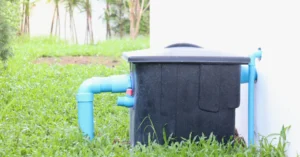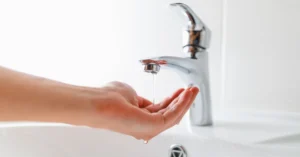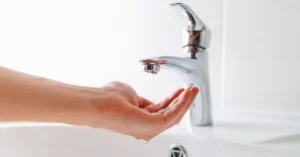If you’ve ever had a sneaking suspicion that your water bill is higher than it should be, you’re not alone. Finding and fixing water leaks in San Diego homes can save you a ton of money, prevent damage to your property, and protect our precious local water supply.
In this ultimate guide, you’ll discover simple ways to detect leaks, learn how to handle minor fixes on your own, and know exactly when to call in a professional.
Understand why leaks happen
Water leaks don’t occur out of thin air. Often, they’re the result of aging pipes, ground shifts, or sudden internal pressure changes. In San Diego, the heat and clay-rich soil can take a toll on the pipes under your property. As the soil expands and contracts with moisture, it puts strain on older pipes, which might already be vulnerable to corrosion.
Common causes of leaks:
- Pipe corrosion: Over time, minerals in tap water can corrode metal pipes. If your pipes are old, you might see rust-colored residue on fixtures or detect a metallic taste in your water
- High water pressure: Although you might enjoy robust water flow, a consistently high PSI (pounds per square inch) can stress weaker spots in your plumbing. This can lead to cracks in pipes or small leaks around connections
- Shifting soil: In many San Diego neighborhoods, clay soil expands when wet and contracts when dry. This back-and-forth movement can warp or crack pipes buried just below the surface
- Wear and tear: Everyday usage gradually weakens pipe joints, faucets, valves, and seals. Even a slight looseness in a fixture can worsen gradually until water drips start appearing
Knowing these reasons helps you watch for signs of trouble long before you’re dealing with a major leak. Professional plumbing repair services can help address these underlying causes before they become bigger problems.
Spot obvious leaks
Obvious leaks typically announce themselves by sound or sight: you see water dripping, hear an incessant drip in the middle of the night, or notice a puddle under a sink. Although they’re easy to spot, it’s still important to jump on them quickly because slow leaks can still rack up water costs in San Diego.
Where to check for obvious leaks:
- Check faucets and showerheads: A steady drip from a faucet can waste gallons of water a day. If you see sporadic water droplets forming even when the faucet is off, consider tightening connections or changing the washer
- Inspect under sinks: Once a week, peek into the cabinets under your kitchen and bathroom sinks. If you spot moisture on the floor of the cabinet, you might have a leaky pipe or faulty seal
- Watch your toilet: If your toilet runs at random times or you hear a continual whooshing sound even when it hasn’t been flushed recently, there could be a hidden leak in the tank or flap
When you catch these obvious leaks early, you can often fix them by replacing worn-out parts. Ignoring them, on the other hand, can lead to structural damage and sky-high monthly bills. The EPA provides helpful water conservation tips for homeowners looking to save water and money.
Identify hidden leaks
Hidden leaks are trickier because, well, they’re out of sight. You might sense their presence only when you see a spike in your water bill or notice a damp patch you can’t explain. In older San Diego homes, hidden leaks are often found behind walls or in ceilings, especially when pipes are nestled in between layers of drywall or plaster.
Here are a few hints that might point to a concealed water leak:
- Unexplained wet spots: If you see any discolored patches on your walls or ceilings, that’s a clue water is collecting behind the surface. Touch it gently: if it feels soft, moist, or spongy, you likely have a leak
- Musty smells: The smell of mildew or mold can mean trapped moisture. Give your walls a sniff (seriously!) to find areas that smell off or musty
- Warped wood floors or baseboards: You might spot slight buckling if water is pooling below the surface. This can happen when a leak is near the foundation or in a wall adjacent to the floor
- An unexplained jump in your water bill: If your usage has stayed more or less the same but you’re paying significantly more, water may be escaping where you can’t see it
By staying in tune with your home’s usual rhythms, you’ll be more likely to catch a hidden leak before it spirals out of control. Professional camera line inspection services can locate hidden leaks without destructive digging or wall removal.
Watch out for clay soil damage
One big factor that sets San Diego apart from other cities is the presence of clay soil in many neighborhoods. While it’s rich and fertile enough for certain landscaping projects, it’s not so friendly to your plumbing. Clay soil swells up when it’s wet, and then it contracts as it dries. This yo-yoing motion can weaken or break your pipes, especially if your home is older and the pipe materials are near the end of their lifespan.
Here’s why that matters, particularly in areas like Chula Vista (91910), La Mesa (91942), and other neighborhoods with clay-rich soil:
- Increased leak risk: The pressure from expanding clay soil can cause hairline fractures in your pipes. These fractures are often enough for water to seep out slowly, leading to hidden leaks that damage your foundation
- Foundation shifts: Repeated expansion and contraction can also shift the very foundation of your home. If you notice cracks in your walls or uneven floors, you might be experiencing more extensive structural movement due to soil conditions
- Harder detection: When you have a slow leak underground caused by shifting soil, it’s not always straightforward to pinpoint where the leak begins and ends. You might need specialized equipment to find and fix it properly
Because of these unique soil challenges, you’ll want to stay alert for any signs of leaks around the perimeter of your home. Keep an eye on your slab foundation (if you have one) or your crawl space for unexplained moisture, cracks, or unevenness. When underground pipe damage occurs, professional plumbing excavation services can safely access and repair damaged lines.
Use modern leak detection tools
When it comes to finding leaks, technology can give you an edge. Modern leak detection tools are more accurate than ever, allowing you to zero in on the source without tearing down entire walls or digging up large sections of your yard. Whether you’re a DIY enthusiast or you prefer hiring an expert, you’ll want to know what’s out there.
Common tools and methods include:
- Water meters: Many San Diego homes have easily accessible meters outside. Turn off all water fixtures in your home, then check the meter for movement. If the dial is still running, water is going somewhere it shouldn’t
- Pressure gauges: A pressure gauge can show you if your system experiences unusual spikes. Attaching one to an outdoor spigot helps you see if your water pressure is consistently reaching levels that damage pipes
- Infrared cameras: Professional plumbers sometimes use thermal imaging cameras to spot temperature variations behind walls. Cooler patches indicate potential leaks
- Acoustic listening devices: These sophisticated tools help detect the sound signature of water escaping from pipes, even if the leak is buried underground
- Smart leak detectors: You can install small sensors near appliances or fixtures that are prone to leaking. These gadgets alert you via an app or email the moment they sense moisture
While you can’t always fix a leak just by discovering its location, having these tools on hand—or knowing how professionals use them—makes the repair process more focused and less invasive.
| Tool or Method | Use Case | DIY-Friendly? |
|---|---|---|
| Water meter check | Quick test for overall system leaks | Yes |
| Pressure gauge | Monitoring water pressure spikes | Yes |
| Infrared camera | Spotting temperature changes in walls | No, typically |
| Acoustic listening | Locating underground or hidden leaks | No, typically |
| Smart leak detector | Real-time alerts for moisture presence | Yes |
Try simple DIY fixes
If the leak appears minor and you feel comfortable handling it, there are straightforward repairs you can do. Think of these as first-aid measures—they won’t replace a professional plumber when the problem is extensive, but they can hold you over or eliminate small leaks for good.
Simple DIY solutions:
- Replace worn-out washers: Washers inside faucets and showerheads eventually degrade or warp. If you notice a drip, simply shut off the water supply, disassemble the faucet, and swap the washer with a new one
- Tighten loose connections: Under your sink, you might see pipes that screw together. Grab a wrench and gently tighten them if you spot any moisture. A small turn is often enough to seal a leak
- Patch pinhole leaks: If you find a tiny hole in a copper pipe, you can apply a pipe clamp or wrap the area with special leak-sealing tape designed for plumbing repairs. This solution is temporary and is best followed up by a permanent fix
- Use plumber’s tape (Teflon tape): For minor leaks around threaded faucets or showerheads, wrapping the threads with Teflon tape can help create a tighter seal and stop drips
Always remember to turn off your water supply before attempting repairs. If you’re unsure about the severity of the leak, calling a professional plumber is your safest bet. For more DIY insights, check out our test of popular drain cleaning hacks that actually work in Southern California homes.
Know when to call a plumber
There’s no shame in asking for expert help, especially if you suspect a hidden leak, own an older property, or notice major changes in your water usage. Plumbing professionals have advanced tools and years of experience to guide their troubleshooting. If you see water bill spikes every month, it’s time for a thorough inspection from a qualified plumbing services provider.
You’ll also want to call a professional if:
- You can’t locate the leak: Sometimes, you only know something’s wrong because you smell mold or hear dripping in the walls, but you have no clue where it’s coming from
- Structural damage is apparent: Cracks in your foundation, warped floors, or persistent staining on walls could mean a serious waterline issue
- You’re dealing with sewer lines: Sewage leaks aren’t just messy, they’re a health hazard. Professional drain cleaning and repair services can handle these safely
- The leak is big: If you notice pools of water forming in your basement, around your yard, or in your driveway, you’re likely dealing with a pipe break larger than a quick fix can handle
Professional intervention methods:
- Advanced camera inspections that allow plumbers to see inside your pipes
- Hydrostatic tests that measure potential leakage in any water or sewer line
- Slab leak detection methods if the leak is under a concrete foundation
Because water is more expensive in San Diego than in many other cities, the cost of ignoring a major leak is often higher than calling in an expert to tackle it right away. For major pipe repairs, modern pipelining and repiping techniques can restore your plumbing with minimal disruption to your home.
Learn more about the financial benefits of professional intervention in our article comparing preventative maintenance vs emergency repairs.
Prevent future leaks
Ongoing vigilance is the best way to keep your water lines healthy. A little effort now can stop major catastrophes (and big costs) down the road. Prevention can be as simple as regularly checking high-risk areas and ensuring your home’s water pressure stays within a normal range.
Weekly or monthly habits might include:
- Listening for unusual sounds around faucets, toilets, and washing machines
- Inspecting crawl spaces or your garage for any dampness along the walls
- Glancing at your water meter to see if anything’s moving when all fixtures are off
If your neighborhood in Point Loma (92106), Oceanside (92054), or Coronado (92118) is known for older plumbing, consider scheduling annual or biannual professional inspections. During these checkups, professionals will look for corrosion, measure the water pressure, and recommend any preemptive repairs. You might also ask for advice on upgrading your pipes to more durable materials that can handle the region’s clay soil and shifting temperatures.
Consider The Solid Care Plan for just $144/year – this maintenance program includes regular inspections that can catch potential leaks before they become expensive emergencies.
Key takeaways
Finding and fixing water leaks in San Diego homes is not just about saving money on your monthly bill, though that’s a great motivation. It’s also about preserving your property’s structural integrity and ensuring your family’s health by avoiding damp conditions that can attract mold.
Here’s a quick recap to keep in mind:
- Obvious leaks, like dripping faucets or running toilets, are easier to spot, so address them quickly
- Hidden leaks often reveal themselves through musty odors, discolored walls, or unexplained spikes in your water bill
- Clay soil expansion and contraction make older San Diego homes especially vulnerable to underground leaks
- Modern detection tools such as acoustic devices, infrared cameras, and smart leak sensors can pinpoint leaks with minimal damage to your home
- If you have basic DIY skills, you can fix small leaks by tightening connections, replacing washers, or using pipe clamps as a temporary measure
- Call a plumber for larger issues, especially if you suspect structural damage or can’t locate the source of the leak
- Prevent leaks by keeping an eye on your water meter, listening for strange sounds, and scheduling regular inspections in older properties
Don’t Let Water Leaks Drain Your Wallet
Water leaks won’t fix themselves, and the longer you wait, the more expensive they become. Whether you’ve spotted obvious signs of a leak in Chula Vista, suspect hidden water damage in Point Loma, or need professional leak detection anywhere in San Diego County, Solid Plumbing & Drains has the expertise and advanced equipment to find and fix leaks quickly.
Our experienced team understands San Diego’s unique soil conditions and the challenges they pose to your plumbing system. From minor repairs to major pipe replacements, we’re here to protect your home and your budget.
Ready to stop water leaks before they become expensive problems? Contact Solid Plumbing & Drains today or call 619-305-1722 for professional leak detection and repair services throughout San Diego County.



